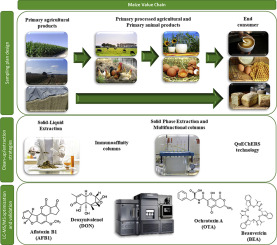Trends in Food Science & Technology ( IF 15.1 ) Pub Date : 2020-03-26 , DOI: 10.1016/j.tifs.2020.03.023 Marta Leite , Andreia Freitas , Ana Sanches Silva , Jorge Barbosa , Fernando Ramos

|
Background
Mycotoxins are natural contaminants produced by fungal species that colonize and contaminate crops, in special cereals, either in the field or in post-harvest commodities. Maize (Zea mays L.) is one of the most valuable crops worldwide, and it is prone to be infected by mycotoxigenic fungi with severe impacts mostly affecting farmers and livestock workers. The constant change in the mycotoxic chart at a European level leads to the need of continuous monitoring, surveillance and control of this major global health and economic issue.
Scope and approach
The latest published studies based on the development of clean-up and extraction strategies with further analysis by liquid chromatography coupled to (tandem) mass spectrometry (LC-MS(/MS)) techniques for the determination of mycotoxins in maize matrices are discussed. Sampling design is also addressed. Sample preparation strategies include Solid-Liquid Extraction, Solid Phase Extraction, multifunctional and immunoaffinity columns, and QuEChERS (Quick, Easy, Cheap, Effective, Rugged and Safe) technology. Validation parameters, including limit of detection, limit of quantification, precision and accuracy are compiled and compared among the different analytical methods.
Key findings and conclusions
A vast number of analytical methodologies has been optimized and validated for mycotoxins determination in maize-based samples, but due to the chemical diversity of these toxins as well as the growing appearance of the so-called emerging mycotoxins, new methods continue to be developed and published. LC-MS/MS has become the golden method for the simultaneous multi-mycotoxin analysis, with different sample preparation approaches, due to the range of different physicochemical properties of these chemicals.
中文翻译:

玉米(Zea mays L.)和霉菌毒素:液相色谱-质谱联用分析方法的优化和验证
背景
霉菌毒素是由真菌物种产生的天然污染物,这些真菌物种在田间或收获后商品中的特殊谷物中定植并污染了农作物。玉米(Zea mays L.)是世界上最有价值的农作物之一,很容易被产毒真菌感染,影响严重,主要影响农民和牲畜工人。在欧洲范围内,霉菌毒素图的不断变化导致需要对该主要的全球健康和经济问题进行持续的监测,监视和控制。
范围和方法
讨论了基于清除和萃取策略的发展以及液相色谱-串联质谱(LC-MS(/ MS))技术进一步分析测定玉米基质中霉菌毒素的最新研究。还介绍了采样设计。样品制备策略包括固液萃取,固相萃取,多功能和免疫亲和柱以及QuEChERS(快速,简便,廉价,有效,坚固和安全)技术。验证参数包括检测限,定量限,精密度和准确性,并在不同分析方法之间进行比较。
主要发现和结论
已经针对玉米样品中的霉菌毒素测定进行了大量优化和验证的分析方法,但是由于这些毒素的化学多样性以及所谓的新兴霉菌毒素的出现越来越多,因此继续开发新方法并开发新方法。发表。由于这些化学品的不同理化特性范围不同,LC-MS / MS已成为采用多种样品前处理方法同时进行多种真菌毒素同时分析的黄金方法。











































 京公网安备 11010802027423号
京公网安备 11010802027423号